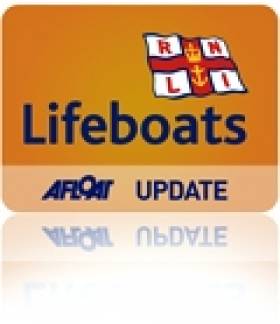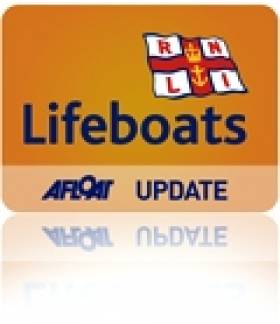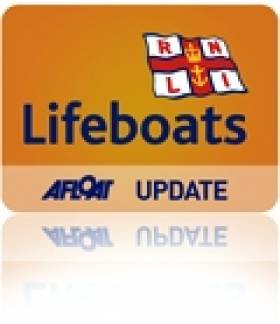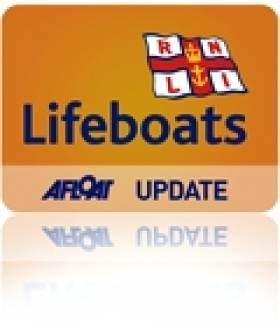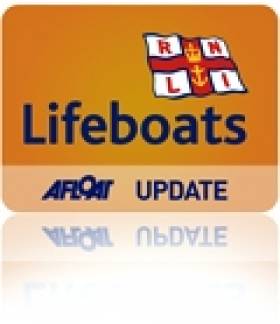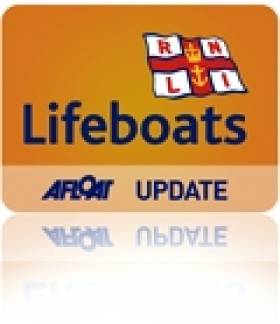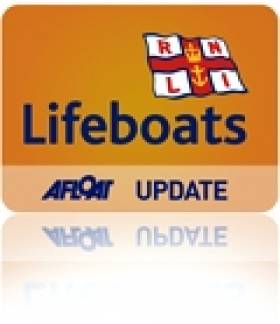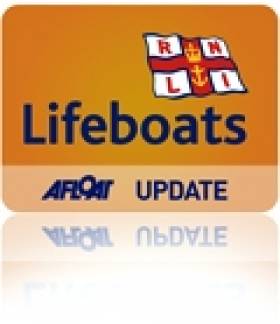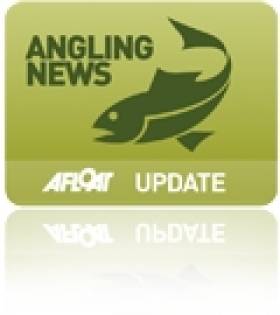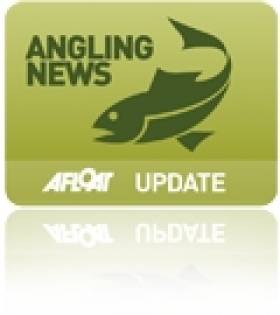Displaying items by tag: Courtown
Wicklow Lifeboat Aids Fishermen, Courtown Volunteers Recognised
#RNLI - Wicklow RNLI's all-weather lifeboat launched shortly after 12.20pm on Friday 29 November to go to the assistance of a stranded fishing vessel.
The lifeboat crew located a vessel drifting nine miles south east of Wicklow Head after 1pm. The fishing boat, with four crew, had suffered engine failure and was unable to return to port.
The volunteer crew quickly established a towline and the fishing vessel was taken back to Wicklow harbour. It was brought alongside the East pier just before 3pm.
The crew on the callout were coxswain Nick Keogh, mechanic Brendan Copeland, Ciaran Doyle, Brendan Kavanagh, Carol Flahive, Dean Mulvihill and Graham Fitzgerald.
In other lifeboats news, a presentation was made to recently honour many years of service from five Courtown RNLI lifeboat crew members.
Volunteer lifeboat crew members Orla Woods, Nuala Sinnott, Brian Bergin and Paul Woods were all recognised for their many years of dedicated service to the RNLI at an event in Courtown's Taravie Hotel.
Crewmember Fintan O'Donoghue was also presented with a statuette to mark his many years of selfless volunteering.
O'Donoghue is still a very active member of Courtown lifeboat and is now a deputy launch officer and station mechanic.
All Courtown lifeboat crew members are volunteers and give their time freely to save lives at seas.
Courtown Lifeboat Assists Stranded Angling Vessel
#RNLI - The Courtown RNLI lifeboat was launched yesterday afternoon (Sunday 17 November) to assist and tow a small 19ft angling boat.
The angling boat had suffered engine failure and required a tow to Courtown Harbour.
The lifeboat, with volunteer crew Glen Deacon, David Switzer and Áine Stafford, went to the assistance of the angling boat and towed it to safety without incident.
Courtown Lifeboat Comes To Aid Of Stricken 'Jaws'
#RNLI - Courtown RNLI was called out on Saturday (10 August) to assist a sailing boat that had run aground on the Bradleys rocks just south of Courtown Harbour in Co Wexford.
The yacht - called Jaws – had been taking part in the weekly club race and had accidentally drifted onto the rocks with three persons on board.
Fellow yacht Yasemin, which had been taking part in the same race, came to assistance and helped tow the yacht off the rocks.
Yasemin then passed the tow over to the Courtown lifeboat, which proceeded to tow Jaws back into harbour. Courtown Lifeboat was then tasked to assist the yacht Nan, which had suffered engine failure and also required a tow into the harbour.
#RNLI - The volunteer lifeboat crew of the Courtown lifeboat launched last Wednesday evening (24 July) to a report of a small fishing boat that was overdue on its time to return to Cahore Pier.
The Courtown RNLI lifeboat, Cahore Inshore Rescue, the Rosslare RNLI lifeboat and the Irish Coast Guard helicopter Rescue 117 were all tasked at 7pm to search the area of Cahore on the north Wexford coast, where the boat was last reported fishing.
After searching for some time, the small fishing boat made contact to say they had beached their boat some eight miles north of Cahore Pier at Kilgorman Beach. Both men were safe and well and all rescue services were stood down.
The Courtown lifeboat has since urged all boat users carry a proper means of communication - ideally a VHF radio - and to keep friends and family up to date on their location, especially if they decide to change their location.
That same evening, Rosslare Harbour RNLI was involved in a search for two fishermen after they reported getting into difficulty off the Wexford coast.
The volunteer crew launched their all-weather lifeboat at 7.30pm to assist in the search following a request from the coastguard to attend a fishing boat that was reported to be taking on water.
Weather conditions at the time were described as good, with a southerly force three wind.
The fishing boat had set out from Cahore Harbour before getting into trouble. The two crew raised the alarm using a mobile telephone.
Rosslare Harbour RNLI and lifeboats from Courtown RNLI and Cahore, along with the Rescue 117 helicopter, joined in the search.
At 7.50pm, Rescue 117 located the two fishermen safe and well and their vessel on the beach at Glasgorman, near Cahore.
Speaking after the call-out, Rosslare Harbour RNLI deputy volunteer lifeboat press officer Jamie Ryan said: "The emergency services responded swiftly and were on scene quickly.
"The two fishermen did the right thing by raising the alarm when they got into difficulty and thankfully they were both found safely ashore."
Busy Times For RNLI At Courtmacsherry And Courtown
#RNLI - Courtmacsherry RNLI assisted two people after their yacht got into difficulty at the weekend.
The volunteer lifeboat crew was called out at 5.15pm on Saturday (13 July) to go to the aid of a yacht off Courtmacsherry Harbour in West Cork.
The all-weather lifeboat with a crew of six was underway within minutes and proceeded to the area where the casualty had developed mechanical failure. The lifeboat arrived on the scene in 10 minutes and proceeded to take the yacht with two people on board in tow.
Both the lifeboat and the stricken vessel were subsequently berthed at the pier in Courtmacsherry village.
This has been a busy week so far for Courtmacsherry RNLI with today's call-out being the fourth in five days.
The others were on Tuesday 9 July to an overdue jet ski in Clonakilty Bay, Thursday 11 July to the aid a windsurfer off Garrettstown, and Friday 12 July to a reported dingy off the Old Head of Kinsale which turned out to be a dead and upturned whale in the sea.
Elsewhere, Saturday was a busy evening for the Courtown lifeboat in Co Wexford.
- lifeboat was launched to a report of two vessels aground in a cove south of Courtown Harbour, quickly locating the vessels – a 15ft speedboat and a personal water craft (PWC) – just south of the harbour in the area known as Salt Rock.
There were two people with the vessels and the speedboat was grounded but swamped.
The lifeboat took both casualties, who were very cold, back to the harbour and then returned first to recover, bail out and tow the speedboat back, and then out to tow the PWC back into the harbour.
The lifeboat then returned to station and refuelled, ready for the Sea Sunday celebrations the following day.
Man Drowns After Rescuing Teens In Courtown Harbour
#RNLI - A man has drowned after attempting to rescue three teenagers who got into difficulty while swimming in Courtown Harbour yesterday 25 May.
The Irish Times reports that the man entered the water after the boys started to struggle in the cold water around lunchtime yesterday.
But despite helping the teens to safety - one of them believed to be his son - the man himself succumbed to the cold.
According to RTÉ News, the Courtown RNLI lifeboat attended the scene within minutes and recovered the 39-year-old from the water, but he was pronounced dead at the scene.
#RNLI - Arranmore RNLI was involved in an epic 12-hour rescue in difficult weather of five fishermen on board a crabber which got into difficulty on St Patrick’s Day.
The station’s all-weather lifeboat was launched at 1.45pm to go to the assistance of the 15-metre fishing vessel which had lost power some 40 miles north west of Arranmore due to a rope getting tangled in the propellers. The five crew members on board the boat were not in immediate danger.
Arriving on scene at 4.30pm, the lifeboat crew, under second coxswain Jimmy Early, established a tow line and proceeded to escort the stricken vessel into Burtonport. However, due to a heavy five-metre swell, the journey was slowed down by the tow line breaking.
Arranmore RNLI volunteer lifeboat press officer Nora Flanagan said: "This was a long callout for all concerned, but our lifeboat crew was delighted that they were able to assist the five crew members and bring them and their fishing vessel safely to shore which they did shortly before 2am this morning (Monday 18 March)."
This was the first long-haul callout for Arranmore’s newest and youngest crew member, 17-year-old Dominic Boyle. The second youngest crew member - Leigh Early, son of coxswain Jimmy - was also on the call.
Meanwhile, three crew members from Courtown RNLI have been presented with animal welfare awards for their bravery in rescuing a woman and her dog from Courtown Harbour last December.
As previously reported on Afloat.ie, the 29-year-old woman got into difficulty when she attempted to rescue her Jack Russell, Holly, from the freezing water off Courtown pier.
The North Wexford Society for the Prevention of Cruelty to Animals (SPCA) awarded David Switzer, Aine Stafford and Fintan O’Donoghue for their efforts in rescuing the woman and her dog.
Colin Webb, chairman of the animal welfare group, said the society took strength from seeing examples of great compassion towards animals in the community.
Arklow RNLI Aids Fishing Vessel Off Courtown
#RNLI - Arklow RNLI came to the assistance of three fishermen whose vessel got into difficulty off the Wexford coast yesterday (6 March).
The volunteer lifeboat crew was alerted shortly before 1.30pm following a report that a fishing vessel was adrift four miles east of Courtown Harbour.
The all-weather lifeboat, the Ger Tigchleaar, was launched within minutes and proceeded to the scene where the vessel, the MFV Telstar, had lost steering power.
Having located the casualty, the crew members established a tow and began the journey back to Arklow. All three crew members who remained on board the MFV Telstar were returned safely ashore.
Speaking ashore, the vessel’s skipper James Russell, himself an Arklow RNLI volunteer crew member and experienced seaman, paid tribute to his fellow lifeboat crew members Eamon Kavanagh, Matt Heaney, Scottie Heaney, Michael Fitzgerald, Andy Loughlin and David Lee who came to his crew’s assistance.
"I thought we were well prepared for situations which might happen at sea but knowing the lifeboat is there when needed is a great help," he said. "When anyone gets in to difficulty they should have no hesitation in calling for help as I did today."
Shore Angling Competition Raises Funds for Courtown Lifeboat
#ANGLING - Strongs winds and heavy seas weren't enough to dampen the spirits of the anglers taking part in the Courtown Sea Anglers RNLI fundraising event last Sunday, the Gorey Guardian reports.
Top winner on the day in the shore angling competition at Kilgorman beach was James Ryan from New Ross, who hooked an impressive 24 fish - all of which went back in the water under catch-and-release rules.
Anglers from Galway, Belfast, Clare, Wicklow, Dublin, Waterford and across Wexford took part. It is hoped that more than €4,200 was raised to support the Courtown lifeboat.
Codling, Coalies Providing Great Sport for Wexford's Winter Anglers
#ANGLING - The winter shore angling season on Wexford's coast has been "exeptional" so far, writes Ashley Hayden in the Enniscorthy Guardian.
With cod shoals moving north into the Irish Sea, some impressive catches of codling have been reported at Tinnebearna and Courtown.
"The cod stock off Ireland's south coast, judging by the fish which I have encountered over the last three years, are now of egg-laying size," writes Hayden.
"Managed properly over the near future, Ireland may just have a working resource again, of benefit to both commercial and recreational interests."
Coalfish are also becoming more prevalent, and are providing great sport to Wexford's shore anglers.
Hayden writes: "Coalies are smash and grab raiders, darting in to grab your bait, hitting it hard before subsequently swimming away and re-grouping, only to have another go."
The Enniscorthy Guardian has more on the story HERE.


























